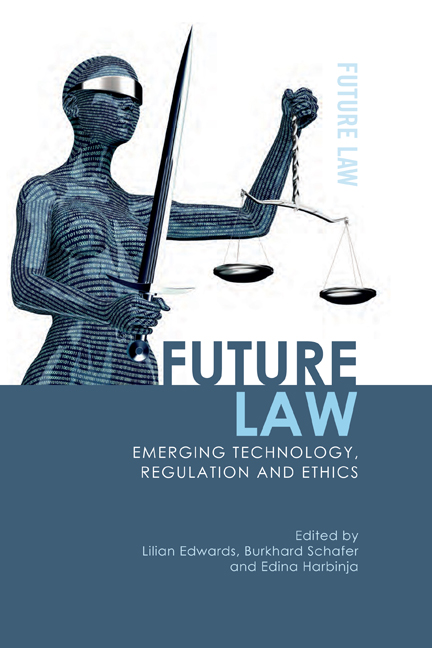Book contents
- Frontmatter
- Contents
- List of Contributors
- List of Figures and Tables
- Table of Cases
- Table of Legislation
- 1 The Future’s Already Here: It’s Just Unevenly Edited
- Part I From Privacy and Princesses, to Security and Star Wars
- 2 Privacy and Identity through the Eyes of Disney Princesses
- 3 White Noise from the White Goods? Privacy by Design for Ambient Domestic Computing
- 4 Citizen-consumers in a Personalised Galaxy: Emotion-influenced Decision Making, a True Path to the Dark Side?
- 5 Big Data Ethics: Darth Vader and the Green Cross Man
- 6 Security Vulnerabilities, Backdoors, Exploits and the Marketplace for Each: The Return of Boba Fett – Bug Bounty Hunter in the New Republic
- Part II A Matter of (Future) Life and Death
- 7 Will My Genes Really Help Me Fit Into Those Jeans? Personal Genomics and Wrap Contracts
- 8 On Living and Undead Wills: ZombAIs, Technology and the Future of Inheritance Law
- 9 ‘Be Right Back’: What Rights Do We Have over Post-mortem Avatars of Ourselves?
- Part III Regulating Autonomous Technologies: Software Are Doing it for Themselves
- 10 Autonomous Intelligent Agents and the Roman Law of Slavery
- 11 Autonomous Vehicles: An Analysis of the Regulatory and Legal Landscape
- Part IV Textual Poaching: Copyright in a Remixed World
- 12 Living in a Remixed World: Comparative Analysis of Transformative Uses in Copyright Law
- 13 Repost This: Instagram and the Art of Re-photography
- Index
11 - Autonomous Vehicles: An Analysis of the Regulatory and Legal Landscape
Published online by Cambridge University Press: 17 September 2020
- Frontmatter
- Contents
- List of Contributors
- List of Figures and Tables
- Table of Cases
- Table of Legislation
- 1 The Future’s Already Here: It’s Just Unevenly Edited
- Part I From Privacy and Princesses, to Security and Star Wars
- 2 Privacy and Identity through the Eyes of Disney Princesses
- 3 White Noise from the White Goods? Privacy by Design for Ambient Domestic Computing
- 4 Citizen-consumers in a Personalised Galaxy: Emotion-influenced Decision Making, a True Path to the Dark Side?
- 5 Big Data Ethics: Darth Vader and the Green Cross Man
- 6 Security Vulnerabilities, Backdoors, Exploits and the Marketplace for Each: The Return of Boba Fett – Bug Bounty Hunter in the New Republic
- Part II A Matter of (Future) Life and Death
- 7 Will My Genes Really Help Me Fit Into Those Jeans? Personal Genomics and Wrap Contracts
- 8 On Living and Undead Wills: ZombAIs, Technology and the Future of Inheritance Law
- 9 ‘Be Right Back’: What Rights Do We Have over Post-mortem Avatars of Ourselves?
- Part III Regulating Autonomous Technologies: Software Are Doing it for Themselves
- 10 Autonomous Intelligent Agents and the Roman Law of Slavery
- 11 Autonomous Vehicles: An Analysis of the Regulatory and Legal Landscape
- Part IV Textual Poaching: Copyright in a Remixed World
- 12 Living in a Remixed World: Comparative Analysis of Transformative Uses in Copyright Law
- 13 Repost This: Instagram and the Art of Re-photography
- Index
Summary
Introduction
Autonomous vehicle technology has developed to the point where manu-facturers now predict that fully autonomous personal vehicles will become commercially available within the next five years. Its implementation has become a policy priority, with the European Commission, for example, out-lining its potential to enhance ‘safety and quality of life; to boost innovation, jobs, and competitiveness; and to maximise the benefits for citizens’ mobility on a European scale’.
The development of autonomous vehicle technology has led to ongoing collaborations between online technology companies, such as Google, and the traditional car industry. NavLab, the Robotics Institute at Carnegie Mellon University in the USA, was one of the first research groups to develop fully autonomous vehicles. The institution recently teamed up with Uber to launch self-driving cars in Pittsburgh and San Francisco. Also in the USA, the Google Self-Driving Car Project has been at the forefront of testing on public roads. Their vehicles have covered more than ten million miles, most of which have been in an urban environment. They equate this to over three hundred years of human driving experience. In the UK, trials are ongoing in Milton Keynes and Greenwich, with collaborative projects such as HumanDrive aiming to complete journeys of over two hundred miles on UK roads by December 2019.
This chapter aims to evaluate how the law interacts with this technology, highlighting regulatory trends and making future predictions. From this analysis, the areas of safety, data protection, access for disabled people and the development of trust have been chosen for closer treatment. The overarching aim of this piece is to highlight key aspects of autonomous personal transport that need to be taken into account while regulating in a manner that does not hinder technological development. This analysis aims to have international reach, as it examines changes made to international legal instruments and subsequently draws out themes from legal and regulatory responses made by the USA, the EU and the UK.
Defining Autonomous Transport
While technology can make a vehicle capable of acting autonomously, the legal and regulatory framework dictates whether or not human control is required and, in this way, can limit its potentially autonomous nature.
- Type
- Chapter
- Information
- Future LawEmerging Technology, Regulation and Ethics, pp. 313 - 340Publisher: Edinburgh University PressPrint publication year: 2020



